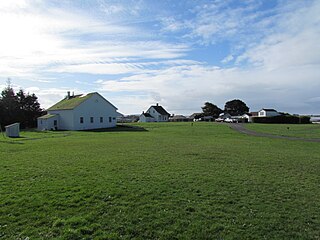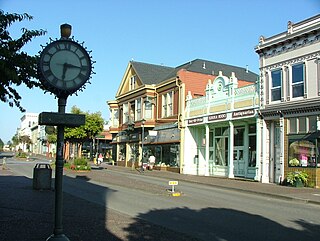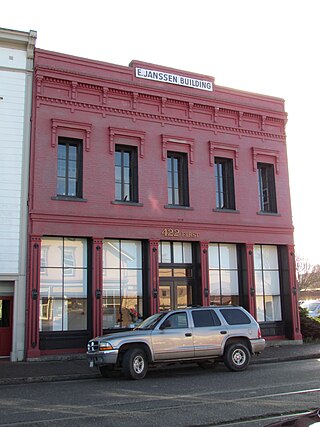
Humboldt County is a county located in the U.S. state of California. As of the 2020 census, the population was 136,463. The county seat is Eureka.

Eureka is a city and the county seat of Humboldt County, located on the North Coast of California. The city is located on U.S. Route 101 on the shores of Humboldt Bay, 270 miles (435 km) north of San Francisco and 100 miles (161 km) south of the Oregon border. At the 2020 census, the population of the city was 26,512 and the population of the greater Eureka area was 48,119.

Ferndale is a city in Humboldt County, California, United States. Its population was 1,481, up from 1,371 at the 2010 census. The city contains dozens of well-preserved Victorian storefronts and homes. Ferndale is the northern gateway to California's Lost Coast and the city, which is sited on the edge of a wide plain near the mouth of the Eel River, is also located near extensive preserves of coast redwood forests.

Humboldt Bay is a natural bay and a multi-basin, bar-built coastal lagoon located on the rugged North Coast of California, entirely within Humboldt County, United States. It is the largest protected body of water on the West Coast between San Francisco Bay and Puget Sound, the second-largest enclosed bay in California, and the largest port between San Francisco and Coos Bay, Oregon. The largest city adjoining the bay is Eureka, the regional center and county seat of Humboldt County, followed by the city of Arcata. These primary cities, together with adjoining unincorporated communities and several small towns, comprise a Humboldt Bay Area with a total population of nearly 80,000 people. This comprises nearly 60% of the population of Humboldt County. The bay is home to more than 100 plant species, 300 invertebrate species, 100 fish species, and 200 bird species. In addition, the bay and its complex system of marshes and grasses support hundreds of thousands of migrating and local shore birds. Commercially, this second-largest estuary in California is the site of the largest oyster production operations on the West Coast, producing more than half of all oysters farmed in California.

The Southwest Museum of the American Indian was a museum, library, and archive located in the Mt. Washington neighborhood of Los Angeles, California, United States, above the north-western bank of the Arroyo Seco canyon and stream. The museum was owned, and later absorbed by, the Autry Museum of the American West. Its collections dealt mainly with Native Americans. It also had an extensive collection of pre-Hispanic, Spanish colonial, Latino, and Western American art and artifacts.

Fort Humboldt State Historic Park is a California state park, located in Eureka, California, United States. Its displays interpret the former U.S. Army fort, which was staffed from 1853–1870, the interactions between European Americans and Native Americans in roughly the same period, logging equipment and local narrow gauge railroad history of the region. Within the collection, there are trains, logging equipment, including a fully functional Steam Donkey engine, and an authentic Native American dug-out canoe. The Fort overlooks Humboldt Bay from atop a bluff. The North Coast regional headquarters of the California State Parks system is located onsite.
The Humboldt Arts Council (HAC) is the official Humboldt County, California, USA arts council located in the Morris Graves Museum of Art (MGMA).

Old Town Eureka in Eureka, California, is a historic district listed on the United States National Register of Historic Places. It is a 350-acre (1.4 km2) area containing 154 buildings mostly from the Victorian era. The core of the district runs the length of First, Second, and Third Streets, between "C" and "M" Streets, and includes many types of architecture including Eastlake, Queen Ann, Greek Revival, Classical Revival, and Second Empire styles from the 1850s to the 20th century. Though not officially within the district, the Carson Mansion commands the highest elevation at the eastern edge of the district.
The Humboldt County Historical Society (HCHS) is a regional historical society, primarily focused on the history of Humboldt County, California. Offices, bookstore, collections, and research staff are located in Eureka.

The Museum of Indian Culture is a 501(c)(3) non-profit organization and educational center in Allentown, Pennsylvania.

The Hotel Arcata is a National Historic Place and fully operational hotel located in Arcata, California. It was built to accommodate visitors to Arcata, California, drawn by the Humboldt State Normal School and delivered by the Northwestern Pacific Railroad. In 1920 the Redwood Highway, US 101 provided more access to Arcata.

The Odd Fellows Hall in Old Town Eureka, California, also known as the French Empire Mansard Building, is a Second Empire architecture style building built in 1883.

The Carnegie Free Library in Eureka, California was built in Classical Revival Style in 1902. It was listed on the National Register of Historic Places in 1986, and currently houses the Morris Graves Museum of Art.

The Carson Mansion is a large Victorian house located in Old Town, Eureka, California. Regarded as one of the premier examples of Queen Anne style architecture in the United States, the house is "considered the most grand Victorian home in America." It is one of the most written about and photographed Victorian houses in California and possibly also in the United States.

Humboldt Bay Woolen Mill manufactured woolen cloth from 1901 to after World War II. The mill was listed as a National Historic Monument but demolished by the City of Eureka in 1987.
The Blue Lake Museum, located in the former Arcata and Mad River Railroad depot at Railroad and G Streets, Blue Lake, California, has photos and artifacts of Blue Lake pioneer, local Indian, logging and railroad history.

The Thomas F. Ricks House, also known as the Y.W.C.A. House, The Palms and St. Francis Hospital at 730 H. Street, Eureka, California was designed and built by Fred and Walter Butterfield in 1885 for owners Thomas Fouts Ricks and his wife, Eva. It was listed on the National Register of Historic Places in October 1992.

The E. Janssen Building at 422 First Street, Eureka, California, is a two-story Italianate commercial building. It was built in 1875 to be a hardware and general merchandise store. In 1973, it was the first building in Eureka to be placed on the United States National Register of Historic Places, and it was listed as a contributing property of the National Register Old Town Eureka Historical District in 1991. From 1998 to 2016, the building housed the HSU First Street Gallery, an art gallery run by Humboldt State University.

Newland House is an 1898 farmhouse in a midwestern adaptation of a Queen Anne architectural style in Huntington Beach, California, United States. Listed on the National Register of Historic Places, it is one of 123 historic places and districts on the National Register of Historic Places in Orange County, California. The Newland House is listed as the ninth historic place to receive a historical plaque from the Orange County Historical Commission in cooperation with the Orange County Board of Supervisors. The house has been identified as the site of the Tongva village of Lupukngna.

Vivien Risling Hailstone was a Yurok/Karok basketweaver, jewelry designer, activist and educator who led efforts to sustain traditional basket weaving patterns and techniques. Hailstone also had an impact on statewide policy for repatriation of Native American remains and returning to Native American names for parks through her involvement with the State of California Department of Parks and Recreation Commission.


















